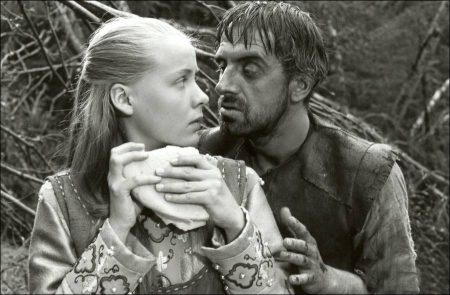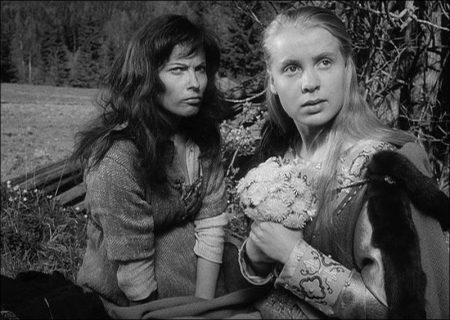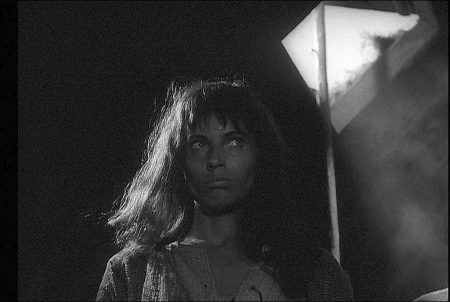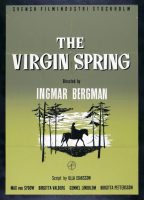The Virgin Spring movie storyline. In Sweden during the Middle Ages, married couple Töre and Märeta are prosperous and devout farmers. They dote on their only surviving offspring, their daughter, the innocent Karin. Their attentiveness to her is despite her faults, such as her vanity and penchant for sleep when she should be doing farm work. It’s early spring, and she is tasked with bringing candles to church for matins.
She convinces her mother to let her wear her Sunday best if only in her want to look pretty. The church is in the nearest village which is still a good distance away, even by horseback. As such, she convinces her parents to allow Ingeri, their pregnant maidservant, to accompany her. Ingeri is secretly envious of Karin if only because of her own lost innocence. Ingeri prays to the Norse God Odin, her latest thoughts to Odin which are against Karin.
Out of circumstance, Karin and Ingeri part company half way through their trek. Ingeri encounters a one eyed man, who she ultimately steers away from despite he being what she wanted. Karin encounters a group of goatherds, three brothers consisting of two adults and an adolescent. The two adult brothers eventually rape and murder Karin, while their younger brother watches. What they are unaware of is that Ingeri, horrified, witnessed both the rape and murder, she who contemplated attacking the brothers during the rape but which she ultimately did not do.
On their travels, the three brothers decide to take refuge at a farm, Töre and Märeta’s farm, the couple who welcome the three into their manor house out of Christian charity. The questions become whether either side will discover their connection, and what Ingeri will do based on her prayers and what she witnessed. Through Karin’s absence, Töre and Märeta critically review their family dynamic.
The Virgin Spring (Swedish: Jungfrukällan) is a 1960 Swedish rape and revenge film directed by Ingmar Bergman. Set in medieval Sweden, it is a tale about a father’s merciless response to the rape and murder of his young daughter. The story was adapted by screenwriter Ulla Isaksson from a 13th-century Swedish ballad, “Töres döttrar i Wänge” (“Töre’s daughters in Vänge”). Bergman researched the legend of Per Töre with an eye to an adaptation, considering an opera before deciding on a film version. Given criticism of the historical accuracy of his 1957 film The Seventh Seal, he also invited Isaksson to write the screenplay. Other influences included the 1950 Japanese film Rashomon. Max von Sydow played Töre.
Isaksson and Bergman explored a number of themes in The Virgin Spring, questioning morals, vengeance, and religious beliefs. The rape scene was also subject to censorship in screenings in the United States. The film won the Academy Award for Best Foreign Language Film at the 1961 Academy Awards and other honours. It was also the basis for the 1972 exploitation horror film The Last House on the Left.
Themes: The questioning of religious faith
A variety of themes explored in the film include Christianity, Paganism, Norse mythology, feelings of guilt, vengeance, the questioning of religious faith and sexual innocence. All of the characters struggle with feelings of guilt, Ingeri for praying to Odin and standing by during the murder, Märeta for disliking Töre and wanting to be Karin’s favourite parent, and Töre for killing the boy and possible feelings of incest towards Karin.
Much of the religious themes centre on conflict between paganism and Christianity, recalling the misery Sweden experienced as the two religions struggled for predominance. In the film, paganism is associated with magic spells, envy and revenge. In a possible interpretation, Odin in this film becomes synonymous with the Devil.
As with The Seventh Seal, Bergman relies on the emotions and inner conflicts of his characters to represent spiritual crisis.[5] Töre, played by Max von Sydow, loses his Christian values to commit the act of revenge, and offers to build a church as redemption. Film scholar Marc Gervais elaborated that Töre’s revenge is “ritualized pagan vengeance”, adding “Töre is torn between two ritualized imperatives: pagan vengeance, Christian repentance and forgiveness”. Gervais commented on how it compared to William Shakespeare’s Macbeth in its themes of “embracing the dark forces, succumbing to evil, and being overwhelmed by conscience”.
Consistent with fairy tales, Karin and Ingeri are presented as opposites, Karin as an innocent virgin who always appears clean and in fine clothing. In contrast, Ingeri is dirty, dark in complexion, rides a darker horse, and her pregnancy indicates compromised innocence. The rape scene represents Karin losing her innocence, with her appearance after being disordered.
Screenwriter Ulla Isaksson viewed the spring as symbolizing Karin’s innocence. Ingeri uses it to wash her head, which she used to plan the spell, and her eyes, which she used to watch the rape, and drinks the water, symbolizing absolution. Critic Peter Cowie tied the spring in with Ingeri’s fire in the opening and streams seen throughout the film as representing “The pagan significance of fire, earth, and water”.
The Virgin Spring (1960)
Directed by: Ingmar Bergman
Starring: Max von Sydow, Birgitta Valberg, Gunnel Lindblom, Birgitta Pettersson, Axel Düberg, Tor Isedal, Allan Edwall, Ove Porath, Gudrun Brost, Leif Forstenberg, Tor Borong
Screenplay by: Ulla Isaksson
Production Design by: P.A. Lundgren
Cinematography by: Sven Nykvist
Film Editing by: Oscar Rosander
Costume Design by: Marik Vos-Lundh
Makeup Department: Börje Lundh
Music by: Erik Nordgren
MPAA Rating: None.
Distributed by: Janus Films
Release Date: February 8, 1960
Visits: 121



